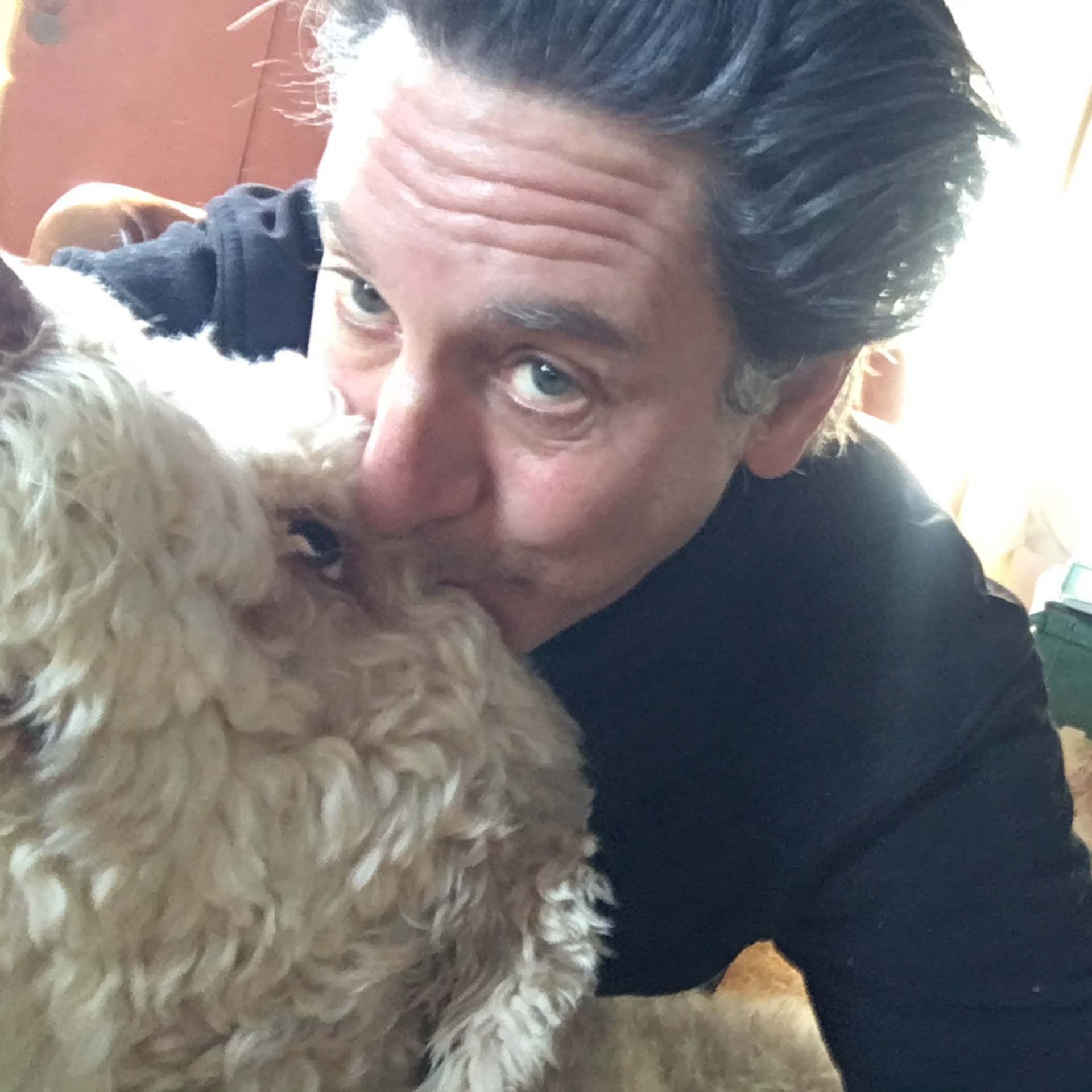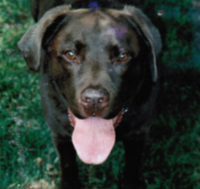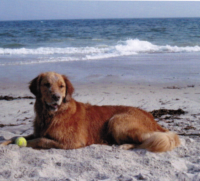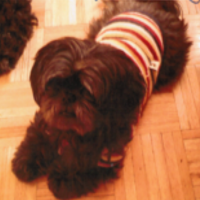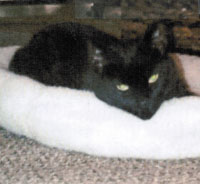This is Fanny and me. We, or I guess she really, are now in the fourth week after her CCL operation almost to the day that her other knee was operated on a year ago. Both by the wonderful, magical, and caring Dr. Haroush. Last year, pre-pandemic, with a looming scare, a big price tag and months of rehab in front of us, Dr. Haroush, Jose and the rest of this magnificent team treated us immediately, helped us in more way we could count all with the kindest and most knowledgeable of treatments. Fanny felt like it was another home and we felt like we were welcome to be as neurotic as we could be about our dog. She healed up quickly and then like clockwork which Dr. Haroush said might happen, it did again, the other knee. Now it was even worse with the Pandemic in full swing, money really tight, time tighter, it felt so huge and totally overwhelming. Did Dr. Haroush come to the rescue? He certainly did. Again, she is healing nicely, we are healing along with her and I would never send her to another vet as long as she lives. Dr. Haroush and team are spectacular in their wisdom and care. Along with treating Fanny it was like he was treating me for all the insanity we are all feeling right now. Everyday and beyond the care was present. And most of all Fanny feels loved and taken care of. What more could you ask for. I wish it was all this simple.
TTA RAPID: The New Face of ACL Surgery
Animal Health Center at Veterinary Village has been instrumental in redefining the role of minimally invasive surgery and diagnostics in veterinary medicine. We utilize the most cutting-edge surgical equipment, techniques, diagnostics, and groundbreaking methods to provide our clients with the highest quality of medical care and most effective solutions.
Call Us Now To Learn More
TTA Rapid, an alternative surgery for the treatment of ACL injuries and was only recently introduced to the United States. Our doctors at Animal Health Center are some of the few veterinary surgeons in the entire world who are experienced with this new biotechnology.
-
More Details on TTA RAPID
The ACL, anterior cruciate ligament, is one of the four main ligaments of the knee, and it helps to stabilize the knee during landing or rotating. Treatment of a torn ACL involves surgery, rehabilitation, and pain management. In some cases rehabilitation, and weight & pain management become part of a lifelong plan for animals, especially if they are older or have predisposed conditions.
TTA Rapid surgery has recently become one of the newest and most effective surgeries available for the treatment of ACL injuries. It most closely restores the normal biomechanics of the knee by using the least invasive surgery to stabilize the joint with minimal arthritic damage to the joint. This procedure is more accurate than other well-used surgeries, resulting in rapid healing, less inflammation, and recovery within weeks of surgery as opposed to months. Additionally, it relies on titanium implants, which carry less risk of infection and rejection and allows for a larger range of movement than in other ACL injury surgeries, such as the TPLO.
TPLO is one type of surgery used by orthopedics for treatment of ACL injuries. In this case the tibia, or weight bearing part of the knee joint, is surgically cut and altered to a different angle; Implants hold the knee in place while the joint heals to its new position. It’s not only extremely invasive, but the accuracy of success is dependent on a multitude of factors, the post-operative healing is extended, and recovery could take months. Additionally, the surgery itself, while helpful in treating the ACL injury, also causes increased forces within the knee, possible permanent loss of some range of motion, and the knee is more difficult to extend post surgery.
If your animal companion has recently had an ACL injury, call Animal Health Center immediately to make an appointment with one of our veterinary surgeons. With our experience, we can ensure that your pet experiences the least amount of pain during, both surgery and post-op, following with a quick and safe recovery without the long-term effects of traditional ACL surgery.
For more information see the Visual Guide below or view the animated video click here.
-
What is the ACL or CCL ?
The Anterior Cruciate Ligament, also known as Cranial Cruciate Ligament, is one of the supporting soft tissue rope-like structure within the knee joint. For the purpose of these definitions, we will use the term ACL.
-
What is an ACL tear or rupture?
An ACL tear is a break in the rope-like structure connecting the femur bone to the tibia bone creating instability and pain in the knee joint.
-
What are the signs of an ACL tear?
The symptoms vary between sever acute lameness to mild chronic ones depending on the degree of the tear. A complete tear will yield an acute and severe lameness as oppose to a partial tear that will yield a mild on and off chronic one. A tear or rupture will lead to joint swelling, pain and instability of the knee joint and when you see the signs on your pet it means that there is already damage (pathology).
-
What is The Treatment for an ACL Tear?
There are a number of treatments for ACL tear and they are divided in 2 main categories: non-surgical and surgical. The non-surgical treatments include pain medication, physical therapy, splints and braces. In general, these treatments yield poor results including chronic painful illness associated with instability , arthritis, meniscal and cartilage damage. These treatments are in most cases are not recommended.
The surgical treatments encompass many procedures. The most recent approach is to change the dynamic or physical anatomy of the joint. TPLO (Tibial Plateau Leveling Osteotomy), TTA (Tibial Tuberosity Advancement) and CBLO (CORA Based Leveling Osteotomy)are the most commonly used techniques. They are designed to change the tibial plateau or the mechanical forces within the joint. These techniques use osteotomy (cut of the bones) with plates, screws and spacers to fix the joint.
Non-invasive or minimally invasive is a key in modern surgery as it is always less traumatic, it provides faster recovery and less pain which are paramount in yielding better results and a quicker return to normal activities.
At Animal Health Center at Veterinary Village, we are using the same equipment and technology as the top human hospital in the world. Using our arthroscopic tool equipped with HD camera and large screen we can assess and attend to any conditions within the joint through small punctures only(https://synergy.arthrex.com). This equals less trauma, less pain, better visualization of the condition resulting in a better diagnosis and better treatment.
-
What is an ACL surgery?
An ACL surgery is a surgery performed to repair an instability that was created by the ACL rupture or tear in the knee joint.
-
What is the Stifle joint?
The Stifle joint is the knee joint.
-
Is a torn ACL painful for a pet?
A torn ACL is painful, and affected pets will experience pain while simply walking. Depending on the severity of the tear, the symptoms may range from showing a hint of lameness to being completely unable to bear weight on the injured leg.
-
What are the causes of an ACL tear?
ACL tears are one of the most common orthopedic diseases veterinarians see in dogs. Research done revealed that in most cases the ACL tear is not a traumatic injury but rather a degenerative change that happens within the joint. There are contributing factors to ACL tear including genetics, hormonal, nutritional, anatomical factor and more.
-
How is an ACL tear diagnosed?
The veterinarian will first perform a physical examination and will evaluate the affected knee, looking for palpable laxity or looseness in the joint known as “drawer” and “thrust”. Then, x-rays will be taken to better evaluate the general condition of the patient and the specific changes within the joint to determine the extent of the ACL damage, the progression of the injury and to rule out other conditions that may be present and contribute to the lameness. The x-rays will also allow the surgeon to take specific measurements such as the tibia slope that are essential to perform the surgery.
Other advanced imagery techniques such as CT, MRI and ultrasound can be used in the diagnosis, and are all available on site at the Veterinary Animal Hospital, but mostly not required.
We strongly suggest performing the diagnosis under anesthesia to reduce the patient anxiousness and facilitate accurate evaluation.
-
What is the best treatment for my dog?
There is no single treatment that fits all. Many factors are to be considered, such as the size, breed, age, level of activity, type of dog (working dog, show dog, etc.). Pre-existing medical conditions for example Medial Patela laxation, excessive tibial slope, hip dysplasia, ecc’ and of course the budget.
The best treatment for your pet will be the least invasive technique that has the best success rate, the least complication rate and the fastest recovery.
-
How long is the recovery after the surgery?
Most of our patients will walk on their leg within 24 to 72 hours of the surgery.
Typically, after a surgery during their short stay at the hospital, patients will get physical therapy.
Most of our patients leave the hospital walking and feeling much better than when they came in.


